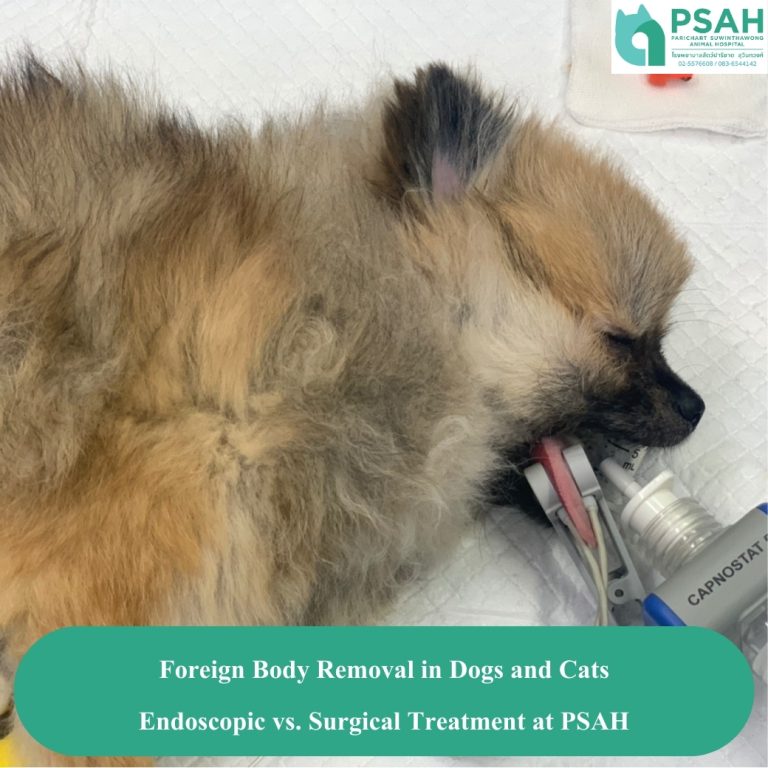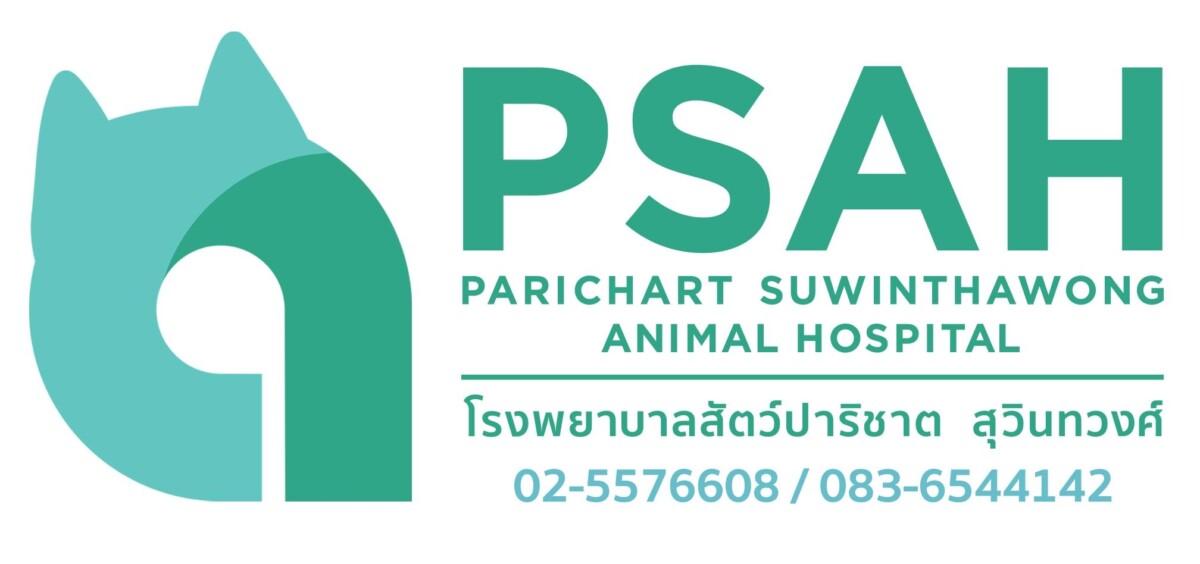Introduction
Foreign body ingestion is a common emergency in dogs and cats, especially for curious pets that tend to chew or swallow non-food items. Prompt veterinary care is critical to avoid severe complications. At Parichart Suwinthawong Animal Hospital (PSAH), we offer both endoscopic and surgical treatments to safely remove gastrointestinal foreign bodies. In this article, we’ll explore the success rates, recovery times, and conditions that dictate when surgery is required, based on veterinary studies and our experience.
What is a Gastrointestinal Foreign Body?
A gastrointestinal foreign body refers to any non-food object that a dog ingests, which then becomes lodged in the digestive tract. Common foreign objects include toys, socks, bones, or even dangerous items like fishhooks. The size, shape, and location of the object play a critical role in determining the treatment method.
In study and practice, some of the most commonly ingested objects include:
– Kid’s toys (14%)
– Metallic objects/coins (13%)
– Cloth (13%)
– Socks (8%)
– Balls (8%)
– Other items such as plastic, peach stones, and fishhooks.
Symptoms of Foreign Body Ingestion
If your dog has swallowed a foreign object, they may show symptoms such as:
– Vomiting (82% of cases in studies)
– Abdominal pain (57% of cases)
– Absence of defecation (31% of cases)
At PSAH, we recommend immediate veterinary attention if your dog exhibits these signs to prevent worsening complications.
Endoscopic Removal at PSAH: A Minimally Invasive Option
When possible, endoscopy is the preferred method for removing foreign bodies. This minimally invasive procedure involves inserting a flexible camera into the gastrointestinal tract to locate and retrieve the foreign object without requiring surgery. It is particularly effective when the object is located in the stomach or duodenum.
In veterinary study:
– Success rate: Endoscopic removal was successful in 56% of cases, with a 100% success rate when the foreign body was located in the stomach or duodenum.
– Hospitalization time: Dogs treated with endoscopy had shorter recovery times, with 42% being discharged within one day.
At PSAH, our advanced endoscopic equipment allows us to quickly and efficiently remove foreign bodies, minimizing your pet’s recovery time and discomfort.
When Surgery is Necessary
While endoscopy is a preferred option for smaller, accessible foreign bodies, surgery is required in certain situations:
– Too Large: If the foreign body is too large to pass through the esophagus or duodenum, endoscopy may not be an option, and surgery is needed.
– Too Round: Rounded objects, such as balls, are difficult to grasp during an endoscopic procedure, necessitating surgical removal.
– Too Friable: If the foreign body is too fragile and prone to breaking apart during endoscopy, surgery may be the safer option to ensure complete removal.
– Linear Foreign Bodies: When a linear foreign body, such as a string or carpet, spans multiple organs—from the mouth to the large intestine—surgical intervention is crucial to prevent further damage to the intestines.
In these cases, a gastrotomy (for stomach objects) or enterotomy (for intestinal objects) may be performed. If the foreign body causes significant damage to the intestines, such as perforation or necrosis, an enterectomy (removal of part of the intestines) may be required.
Risks of Multiple Enterectomy Procedures
In some cases where a foreign body has caused extensive damage, multiple intestinal sections may need to be removed, and an anastomosis (surgical reconnection of the intestines) is performed. However, studies show that multiple enterectomies and anastomoses are associated with a lower survival rate. In particular:
– Dogs that required enterectomy had only a 33% survival rate.
– Surgical procedures involving multiple incisions are often linked to complications such as intestinal dehiscence, infection, or peritonitis, which can reduce the chance of a successful recovery.
At PSAH, our team of experienced surgeons is equipped to handle these complex cases while minimizing risks and improving outcomes wherever possible.
Timely Intervention is Key
Studies have shown that dogs with prolonged vomiting (more than 24 hours) face a significantly worse prognosis. Dehydration, reduced blood flow to the intestines, and increased risk of perforation can all contribute to the need for more invasive surgeries. Early diagnosis and treatment can prevent many of these complications, increasing the likelihood of a full recovery.
At PSAH, we are committed to providing prompt emergency care for foreign body ingestion. Our team works quickly to stabilize your pet and determine the best course of treatment, whether endoscopic or surgical.
Why Choose PSAH for Foreign Body Removal?
At Parichart Suwinthawong Animal Hospital, our experienced team offers a comprehensive approach to foreign body removal, utilizing both endoscopic and surgical techniques to ensure the best outcome for your pet. We have advanced diagnostic tools and state-of-the-art equipment to manage foreign body cases with precision and care.
Whether your pet requires minimally invasive endoscopy or more complex surgery, you can trust PSAH to provide expert veterinary care with a focus on fast recovery and long-term health.
Conclusion
Foreign body ingestion is a serious and sometimes life-threatening condition for your pets. At PSAH, we provide both endoscopic removal and surgical intervention to treat your pet that have ingested foreign objects. If your pet shows signs of foreign body ingestion, such as vomiting or abdominal pain, contact Parichart Suwinthawong Animal Hospital immediately for the best chance of a successful recovery. Early intervention can make all the difference between a quick recovery and a complicated, risky surgery.


